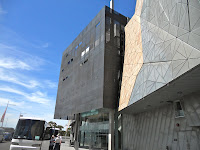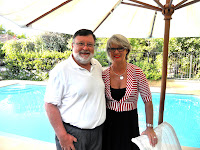
January 20, Friday
John says he takes back whatever he said about Canberra being dull.
We had a fine day today exploring the monuments and edifices of Australian democracy in this planned capital. Now, remember, this is a government town. It’s a metro of about 350,000, which means that it’s a company town, dedicated to government, and the educational establishment at the Australian National University. But in its own way it’s got charm. Lake Burley Griffin, named after the American architect who designed the capital, the series of circles and broad boulevards, which feel lik
e broad boulevards, the shrubbery and forestry, the distant hills and the grand buildings, all make it an imposing city.



In it are fine places to visit for historians and government junkies, like us. The aboriginal art exhibit at the National Gallery of Australia is magnificent. It is so intense that it is overwhel
ming, from the collection of coffins standing like digeridoos on the first floor to commemorate the Aborigines loss of their lands and lives to the settling Europeans to the paintings from the Patunya times that we recognized by style and content from our visit to the exhibit in Melbourne. Coupled with the settler Australian art that is a time-line from discovery to modern days, particularly Russell Drysdale’s magnificent work The Drover’s Wife, the museum gave us a fine overview of Australian culture. The Drover’s Wife, incidentally, was given to the gallery by Benno Schmidt, once president of Columbia University.
From there we walked across one of the city’s many parks, to the Old Parliament Building that dates from the 1920s when Canberra became the capital city. The building is done in 1920s basic style and truly isn’t very charming. There is nothing magnificent about it. The Senate and House chambers lack vitality and it is merely an historical site. Our host shared with us that it may have been done so simply because the rich cities of Melbourne and Sydney had both lost out to the upstart new capital and were not pleased and not interested in making it at all glamorous.

After lunch at The Pork Barrel (the same words we use for the same acts) we walked to the new Parliament Building up the hill. This is a very strong 1980s statement about Australia, almost strident in its strength from the building’s growth out of hill on which it sits, overlooking the whole city, to its aluminum four-part tower on which flies the Australian flag. It is, unlike our own Capitol (even before 9/11) completely approachable by the public. Though our host says it is considered a bit on the small side now, for all the work that goes on inside, it has an interior grandeur, with a lightness of touch, that meets with Australia’s place in the world today. The House is done in light blues and tans, while the Senate is more formal in shades of dusty rose. And its roof commands a 360 degree view of the entire basin where Canberra sits.
We are staying with our friend Tim, who lived in Washington when he worked at the Australian Embassy and was a constant and well-liked visitor in our home for nearly three years. We had promised to visit him in Canberra and he is making us very welcome. We had a good dinner at home with lovely Tazzy champagne last night, and a superb McLaren merlot and a roast beef loin. MMMM...
Our night before with Andrew and Angie and their sons Hugo and Angus was a hoot. Their home in Hawthorn was a train ride from the city--all ten minutes of it. We quaffed several wines, including a Saint Clair NZ sauvignon blanc we’d picked up at the liquor store, a Geelong Bellarine chardonnay, and then two lovely red wines and a sauterne like dessert wine. This was coupled with conversation that ranged from finance to education to American and Australian politics. They walked us to the tram to get home and we were in bed by midnight. Although Melburnians disparage their transport system, it is superb until after midnight when it virtually stops.


Andrew and Angie have visited us in Washington with their sons, ten years ago, and we saw them at their place in Fairhaven, down on the coast, our last visit. We enjoy their company. Wonderful, too,to see how the boyts had grown up.
The following morning we arose, said our goodbyes to our excellent host Ian at 169 Drummond BnB, and headed off to Southern Cross Station. The train ride to Cootamundra was excellent. The countryside is mostly ranches and fields as the train travels through small towns, stopping at only a few. Unfortunately we did not have a train all the way from Melbourne to Canberra because there are none, so we had the last three hours on two lane roads through small villages on a bus.
Pretty but uncomfy to say the least.
Tim met us when we arrived and immediately showed us the town. Then we went searching for kangaroos, which we found eating the grass and flowers at one of the cemeteries. They are truly a strange animal. Generally not afraid of humans. The joeys were a bit too big to fit in their mothers’ pouches, but they were trying. These ‘roos were not large, unlike those we had seen on previous visits, but John still wouldn’t want to be jumped on by the legs on a roo standing a meter high.
Tonight we are off to a restaurant for dinner. More to come. Tomorrow it’s to Sydney, our last stop before our return to the States, to see the Currans who lived up the street from us in Washington for six months.
Saturday, January 21
Last night’s meal was at an aerie of a restaurant named OnRed, perched on Red Hill overlooking the glittering city. It was an elegant place to sit and talk and even more fascinating when the night-time thunder storm rolled through the valley with fiery lightening and sheeting rains. It’s a circular restaurant with views in all directions. The food was small plates, excellent tidbits. We started with a Victorian BWE Pyrenees champagne , then moved on to the tapas with each of the six of us having three each. They ranged from goat cheese, the spinach filled ravioli with ricotta to duck, sweetbreads and even pork belly crisped up. The wines to go with were a Bourke chardonnay from the Canberra region, which was excellent, and a Locan Pinot Noir, also from Canberra, from Bunengdor.
What made the evening so enjoyable though was the company. The guests included Jennifer, whom we’d known in Washington when she had been the ambassador’s private secretary. She had returned to Canberra from Washington to retire, but changed her mind, has been working for the Australian official assigned to ASEAN and is now going to Tokyo for two years. A far cry listening to her on her prospective move compared to the Thanksgiving dinner we had with her about five years ago.
The second guest was David, a friend of Tim’s who is leaving for London to work in the High Commissioner’s office with his wife and kids. David had just been honored by the Peruvian government for his work, and the other guest was the Ambassador from Peru to Australia, Luis, who was wonderful to talk to, and whom we will hope to see again. All of the guests had been to Washington, and we had been to Lima, as had Tim and David, so it was a international interchange of conversation and interests. It was an evening of discussions of American politics and the presidential elections as well as Australia and its history.


We arrived home well after midnight and today we head off to Sydney. Tim, shortly after hosting us and leaving us at the bus terminal, heads off to Wellington, New Zealand for a week with a friend who is going to Noumea, the capital of New Caledonia.
 Wednesday, January 25
Wednesday, January 25
 hill. Quite an installation.
hill. Quite an installation.





















































